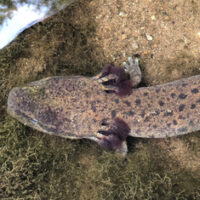 Purdue University - Extension - Forestry and Natural Resources
Purdue University - Extension - Forestry and Natural Resources
Got Nature? Blog
MyDNR, Indiana’s Outdoor Newsletter: All annual licenses and stamp privileges from last season expire on March 31. Purchase your 2024 license online, in person, or b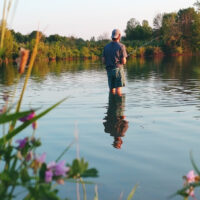 y mail, and check out our Licenses & Permits webpage for more information on license expiration dates and fees.
y mail, and check out our Licenses & Permits webpage for more information on license expiration dates and fees.
Once you have your new license, start planning for your spring fishing fun. The DNR starts stocking fish in early April, and you can take advantage of these opportunities to get an early start on your spring fishing adventures.
View fish stocking locations on the fish stocking webpage and Urban Fishing webpage. Mark your calendars for May 12, the first Free Fishing Day of the year.
To subscribe to the newsletter visit MyDNR Email Newsletter.
Resources:
Hybrid Striped Bass Farmed Fish Fact Sheet, The Education Store
Largemouth Bass Farmed Fish Fact Sheet, The Education Store
Seafood Basics: A Toolkit for Understanding Seafood, Nutrition, Safety and Preparation, and Sourcing, The Education Store
Walleye Farmed Fish Fact Sheet, The Education Store
Rainbow Trout Farmed Fish Fact Sheet, The Education Store
A Guide to Small-Scale Fish Processing Using Local Kitchen Facilities, The Education Store
Aquaculture Family Coloring Book Development, The Education Store
Eat Midwest Fish, Illinois-Indiana Sea Grant online resource hub
Ask an Expert: Wildlife Food Plots, video, Purdue Extension – FNR YouTube Channel
How to Build a Plastic Mesh Deer Exclusion Fence, The Education Store
Managing Your Woods for White-Tailed Deer, The Education Store
Handling Harvested Game: Episode 1, Field Dressing, video, Purdue Extension – FNR YouTube Channel
Deer Harvest Data Collection, Got Nature? Blog, Purdue Extension – FNR
Age Determination in White-tailed Deer, video, The Education Store
Subscribe to Purdue Extension-Forestry & Natural Resources YouTube Channel, Wildlife Playlist
Indiana Department of Natural Resources
Illinois-Indiana Sea Grant Newsroom: The U.S. Department of State and the Fulbright Foreign Scholarship Board announced earlier this year that Kwamena Quagrainie of Purdue University received a Fulbright Specialist Program award. Through April and May of 2023, Dr. Quagrainie completed a project at Kwame Nkrumah University of Science and Technology, training faculty and graduate students about the economics of aquaculture. The project’s aim was to exchange knowledge and establish partnerships benefiting participants, institutions, and communities both in the U.S. and overseas through a variety of educational and training activities within the field of agriculture.
Dr. Quagrainie is one of over 400 U.S. citizens who share expertise with host institutions abroad through the Fulbright Specialist Program each year. Recipients of Fulbright Specialist awards are selected on the basis of academic and professional achievement, demonstrated leadership in their field, and their potential to foster long-term cooperations between institutions in the U.S. and abroad.
The Fulbright Program is the flagship international educational exchange program sponsored by the U.S. government and is designed to build lasting connections between the people of the United States and the people of other countries. The Fulbright Program is funded through an annual appropriation made by the U.S. Congress to the U.S. Department of State. Participating governments and host institutions, corporations, and foundations around the world also provide direct and indirect support to the Program, which operates in over 160 countries worldwide.
For full article and videos please visit Kwamena Quagrainie receives Fulbright Specialist award to Ghana – IISG
Resources
A Guide to Marketing for Small-Scale Aquaculture Producers, The Education Store
A Guide to Small-Scale Fish Processing Using Local Kitchen Facilities, The Education Store
Marine Shrimp Biofloc Systems: Basic Management Practices, The Education Store
Aquaculture Industry in Indiana Growing, Purdue Today
Walleye Farmed Fish Fact Sheet: A Guide for Seafood Consumers, The Education Store, Purdue Extension resource center
Sustainable Aquaculture: What does it mean to you?, The Education Store
The Benefits of Seafood Consumption The Education Store, Purdue Extension Resource Center
Walleye Farmed Fish Fact Sheet: A Guide for Seafood Consumers, The Education Store, Purdue Extension resource center
Pond and Wildlife Management website, Purdue Extension
Fish Cleaning with Purdue Extension County Extension Director, Got Nature? Blog, Purdue Extension – Forestry and Natural Resources
Aquatics & Fisheries, Playlist, Purdue Extension – Forestry and Natural Resources
Eat Midwest Fish, Illinois-Indiana Sea Grant online resource hub
Illinois-Indiana Sea Grant (IISG)
Wild Bulletin, Indiana Department of Natural Resources (DNR) Fish and Wildlife: The Division of Fish & Wildlife asks anglers to report sightings of the mudpuppy (Necturus maculosus) to help biologists track their populations across the state. A Species of Special Concern in Indiana, this salamander inhabits the state’s lakes and streams.
Mudpuppies, like fish, live their entire lives in water, but they are more secretive and difficult to locate. During winter, mudpuppies move into shallow water and are more frequently caught by anglers. They may also be viewed from shore using a flashlight at night, while they walk along the lake bottom. Mudpuppies are not dangerous or poisonous. They can be identified by the red, fluffy gills on the back of their head, but the gills tend to lay flat against their body when they are out of the water.
If you catch a mudpuppy while fishing, please photograph it, cut your fishing line, and release the mudpuppy back into the water. Report your observation to the DNR herpetologist at HerpSurveys@dnr.IN.gov and include a clear photograph of it, the date, and the location where it was found. The DNR appreciates your help tracking this unique salamander.
To learn more please visit DNR: Amphibians and Reptiles.
Resources:
Researchers Discover Young Hellbender in Blue River, Purdue Forestry and Natural Resources News & Stories
Help the Hellbender, North America’s Giant Salamander, The Education Store
Help the Hellbender, Purdue College of Agriculture
Question: Which salamander is this?, Got Nature? Blog, Purdue Extension – Forestry and Natural Resources
Is it a Hellbender or a Mudpuppy?, Got Nature? Blog
Amphibians: Frogs, Toads, and Salamanders, Purdue Nature of Teaching
A Moment in the Wild, Playlist, Purdue Extension – Forestry and Natural Resources
Help the Hellbender, Playlist & Website
The Nature of Teaching: Adaptations for Aquatic Amphibians, The Education Store, Purdue Extension resource center
Hellbenders Rock!, The Education Store
Indiana Department of Natural Resources
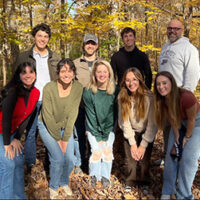 Dr. Rod Williams, extension wildlife specialist Nick Burgmeier and the Help the Hellbender team were honored for their collaboration with partners, outreach to the community and awareness education with the 2023 Indiana Friend of Conservation Award on January 9 in Indianapolis. The award, sponsored by Brownfield Ag News and presented by the Indiana Association of Soil and Water Conservation Districts (IASWCD) at its annual Conservation Awards Luncheon, recognizes individuals of entities who have made an outstanding contribution to soil and water conservation in Indiana. State level honorees are named in the corporate, individual and nonprofit/government categories.
Dr. Rod Williams, extension wildlife specialist Nick Burgmeier and the Help the Hellbender team were honored for their collaboration with partners, outreach to the community and awareness education with the 2023 Indiana Friend of Conservation Award on January 9 in Indianapolis. The award, sponsored by Brownfield Ag News and presented by the Indiana Association of Soil and Water Conservation Districts (IASWCD) at its annual Conservation Awards Luncheon, recognizes individuals of entities who have made an outstanding contribution to soil and water conservation in Indiana. State level honorees are named in the corporate, individual and nonprofit/government categories.
Burgmeier and Eliza Hudson, the Farmers Helping Hellbenders Project Coordinator for the Regional Conservation Partnership Program, accepted the award on the Help the Hellbender team’s behalf.
The team was nominated for the state level award in the nonprofit/government category by virtue of receiving the Washington County Soil & Water Conservation District’s Friend of Conservation Award in February.
The eastern hellbender (Cryptobranchus alleganiensis alleganiensis) is a large, fully aquatic salamander, nicknamed the snot otter, water dog, devil dog, Allegheny alligator and water eel among other things. Their decline statewide has been documented as far back as the early-to-mid 1900s as a result of habitat loss and poor water quality. Hellbenders play an important role in aquatic ecosystems and are indicators of clean water.
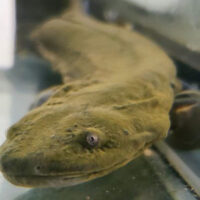
For much of the last 17 years, Williams and his team have been researching eastern hellbenders, spearheading regional conservation efforts and advancing hellbender captive propagation, or the rearing of this ancient animal in captivity and their eventual return to the wild. The partnership had a major breakthrough over the summer with the documentation of a young hellbender salamander in the Blue River while conducting routine surveys. This discovery is significant because over the past three to four decades, only adult hellbenders have been documented in the Blue River. The presence of a young salamander suggests that conservation efforts and rearing programs are accomplishing their goals for the recovery of this endangered species.
The Help the Hellbender lab is actively collaborating with the Indiana Department of Natural Resources, Indiana Division of Fish and Wildlife and The Nature Conservancy as well as several other partners across 13 states on a number of conservation projects and educational opportunities forteachers and children, farmers and more.
To see the full article please visit the FNR News & Stories page.
Resources:
Help the Hellbender website
Help the Hellbender Facebook page
Ask the Expert: Learn All About Hellbenders and Take a Tour, Subscribe Purdue Extension – Forestry & Natural Resources (FNR) YouTube Channel
Ask the Expert video: Help the Hellbender – Dr. Stephen Spear of The Wilds, Purdue Extension – FNR YouTube Channel
Ask the Expert video: Live with Mesker Park Zoo and Botanical Gardens – Hellbenders, Purdue Extension – FNR YouTube Channel
A Moment in the Wild video: Hellbender Hide, Purdue Extension – FNR YouTube Channel
A Moment in the Wild video: Release Moment of Hellbenders,
How Anglers and Paddlers Can Help the Hellbender video, Purdue Extension – FNR YouTube Channel
Eastern Hellbender ID Video, Purdue Extension – FNR YouTube Channel
Hellbenders Rock!, The Education Store, Purdue Extension’s resource center
Help the Hellbender, North America’s Giant Salamander, The Education Store
How Our Zoos Help Hellbenders, The Education Store
The Nature of Teaching: Adaptations for Aquatic Amphibians, The Education Store
Healthy Water, Happy Home – Lesson Plan, The Education Store
Purdue Expert: Hellbender Salamander, Purdue University News YouTube Channel
FNR Assists in First Natural Breeding of Eastern Hellbender in Captivity, Purdue FNR News & Stories
Helping the Hellbender: Mesker Park Zoo Begins Captive Breeding Efforts, Purdue Agriculture News
Wendy Mayer, FNR Communications Coordinator
Purdue University Department of Forestry and Natural Resources
Indiana Association of Soil and Water Conservation Districts (IASWCD)
Are you curious about eastern hellbender salamanders? Learn about their biology, ecology and the work that is being done in Indiana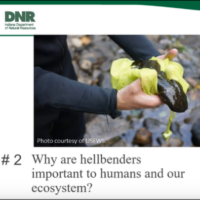 and beyond to restore the populations of this endangered species in a newly released webinar from the Indiana Department of Natural Resources.
and beyond to restore the populations of this endangered species in a newly released webinar from the Indiana Department of Natural Resources.
The “Conservation of the Hellbender: Experts Unite” webinar, which originally took place on Nov. 14, 2023, features a panel discussion between FNR Extension wildlife specialist Nick Burgmeier, Nate Engbrecht, Indiana state herpetologist, and Leigh Ramon, animal curator at Mesker Park Zoo and Botanic Gardens).
The webinar is now available on the Indiana Department of Natural Resources’ YouTube channel.
For much of the last 17 years, Dr. Rod Williams and his team have been researching eastern hellbenders, spearheading regional conservation efforts and advancing hellbender captive propagation, or the rearing of this ancient animal in captivity and their eventual return to the wild. Beginning January 2024, Dr. Jason Hoverman will act as lead investigator for the Help the Hellbender lab’s work at Purdue.
Purdue’s hellbender lab is actively collaborating with the Indiana Department of Natural Resources, Indiana Division of Fish and Wildlife and The Nature Conservancy as well as several other partners across 13 states on a number of conservation projects and educational opportunities forteachers and children, farmers and more.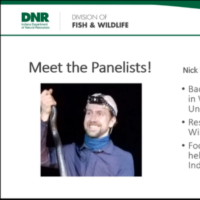
The “Farmers Helping Hellbenders” project, led by Williams and Purdue Extension wildlife specialist/Help the Hellbender project coordinator Nick Burgmeier, was selected in August 2022 to receive $2.7 million in funding through the RCCP Classic fund. The project aims to improve hellbender habitat in a four-county region in south central Indiana, the only remaining habitat for hellbenders in the state, by expanding the use of agricultural conservation practices that lead to decreased sedimentation in local rivers systems. Williams talks more about hellbenders and the project in this YouTube video.
The Indiana Hellbender Partnership is a collaboration between the Indiana DNR and Purdue University with funding support from the Indiana DNR Nongame Wildlife Fund, U.S. Fish & Wildlife Service, and partners in local governments, universities, non-governmental organizations, and zoos that are working to recover the state-endangered hellbender. Developed over 15 years, the Indiana Hellbender Partnership is the largest and most comprehensive group working to recover an imperiled amphibian in Indiana.
Resources:
Help the Hellbender website
Help the Hellbender Facebook page
Ask the Expert: Learn All About Hellbenders and Take a Tour, Subscribe Purdue Extension – Forestry & Natural Resources (FNR) YouTube Channel
Ask the Expert video: Help the Hellbender – Dr. Stephen Spear of The Wilds, Purdue Extension – FNR YouTube Channel
Ask the Expert video: Live with Mesker Park Zoo and Botanical Gardens – Hellbenders, Purdue Extension – FNR YouTube Channel
A Moment in the Wild video: Hellbender Hide, Purdue Extension – FNR YouTube Channel
A Moment in the Wild video: Release Moment of Hellbenders, Purdue Extension – FNR YouTube Channel
How Anglers and Paddlers Can Help the Hellbender video, Purdue Extension – FNR YouTube Channel
Eastern Hellbender ID Video, Purdue Extension – FNR YouTube Channel
Hellbenders Rock!, The Education Store, Purdue Extension’s resource center
Help the Hellbender, North America’s Giant Salamander, The Education Store
How Our Zoos Help Hellbenders, The Education Store
The Nature of Teaching: Adaptations for Aquatic Amphibians, The Education Store
Healthy Water, Happy Home – Lesson Plan, The Education Store
Wendy Mayer, FNR Communications Coordinator
Purdue University Department of Forestry and Natural Resources
Indiana Department of Natural Resources (IN DNR)
Bluegill, also called bream, brim, sunfish, or panfish, are freshwater finfish in the Centrarchidae family. The native range includes the St. Lawrence-Great Lakes and Mississippi River basins from New York to Minnesota south to the Gulf; and Atlantic and Gulf Slope drainages from Virginia to Florida and Texas to New Mexico. They are found in slow moving streams, lakes, ponds, and reservoirs. They have deep bodies; tall and flat sides; and bluish coloration on the gill covers, or operculum. A dark spot at the base of the dorsal fin, small mouth, and vertical bars on the sides distinguish them from similar species. Often breeding with other sunfish species, resulting offspring can be distinctly shaped and colored.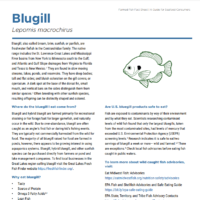
Where do the bluegill I eat come from?
Bluegill and hybrid bluegill are farmed primarily for recreational stocking or for forage/bait for larger game fish, and naturally occur in the wild. Due to over-abundance, bluegill are often caught as an angler’s first fish or during kid’s fishing events. They are typically not commercially harvested from the wild for food. The majority of all bluegill raised for food are farmed in ponds, however, there appears to be growing interest in using aquaponics systems. Bluegill, hybrid bluegill, and other sunfish species can be purchased directly from farmers or pond and lake management companies. To find local businesses in the Great Lakes region selling bluegill visit the Great Lakes Fresh.
To receive the free download and recipe visit the Purdue Extension’s resource center: The Education Store – Bluegill Farmed Fish Fact Sheet.
Resources:
Hybrid Striped Bass Farmed Fish Fact Sheet, The Education Store
Freshwater Prawn Farmed Fish Fact Sheet, The Education Store
Ask An Expert: What is Aquaculture?, Purdue Extension FNR YouTube Channel
Walleye Farmed Fish Fact Sheet, The Education Store, Purdue Extension’s resource center
Pacific White Shrimp Farmed Fact Sheet, The Education Store
Yellow Perch Farmed Fish Fact Sheet, The Education Store
Tilapia Farmed Fish Fact Sheet, The Education Store
Rainbow Trout Farmed Fish Fact Sheet, The Education Store
American Paddlefish, The Education Store
A Guide to Small-Scale Fish Processing Using Local Kitchen Facilities, The Education Store
Aquaculture Family Coloring Book Development, The Education Store
Channel Catfish, The Education Store
Eat Midwest Fish, Illinois-Indiana Sea Grant online resource hub
Amy Shambach, Aquaculture Marketing Outreach Associate
Purdue Department of Forestry and Natural Resources/Illinois Indiana Sea Grant Program
Wild Bulletin, Indiana Department of Natural Resources (DNR) Fish and Wildlife: In 2023, we saw wildlife wins for many rare and endangered species. We found a very young hellbender salamander in the Blue River and increased public awareness and interest in bat conservation. We discovered the banded pygmy sunfish at Twin Swamps Nature Preserve and doubled the number of active barn owl nests from five years ago.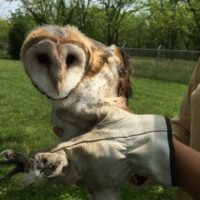
These wildlife wins would not have been possible without those who support the Nongame Wildlife Fund. To all of you who help care for Indiana’s rare and endangered wildlife, thank you!
If you’d like to make a positive impact on Indiana’s wildlife, consider getting involved today. Subscribe to the Indiana DNR Division of Fish & Wildlife Newsletter, IN Fish & Wildlife Instagram, and IN Fish & Wildlife Facebook to stay up to date with the IN DNR-Division of Fish & Wildlife’s latest wildlife wins. Make a volunteer profile and learn more about how to become a DNR volunteer, or make a donation to the Nongame Wildlife Fund. For every $50 given to the Nongame Wildlife Fund, an additional $43 is unlocked in federal funding, making every dollar you donate go even further for Indiana’s wildlife.
To learn more please visit DNR: Nongame and Endangered Wildlife.
Resources:
Researchers Discover Young Hellbender in Blue River, Purdue Forestry and Natural Resources News & Stories
Help the Hellbender, North America’s Giant Salamander, The Education Store
Help the Hellbender website
Help the Hellbender Facebook page
Barn Owl, Indiana Department of Natural Resources
Bats in Indiana, Indiana Department of Natural Resources (IN DNR)
Bat Houses, Bat Conservation International
Creating a Wildlife Habitat Management Plan for Landowners, The Education Store, Purdue Extension’s resource center
Ask an Expert: Turtles and Snakes, video
Ask an Expert: Managing Your Property for Fish and Wildlife, video
A Template for Your Wildlife Habitat Management Plan, publication
Frost Seeding to Establish Wildlife Food Plots and Native Grass and Forb Plantings, video
Connecting Youth to Wildlife Webinar
A Template for Your Wildlife Habitat Management Plan, The Education Store
Indiana Department of Natural Resources
Wild Bulletin, Indiana Department of Natural Resources (DNR) Fish and Wildlife: Indiana DNR has been working with neighboring states to address the invasive carp problem in our waters. The Kentucky Department of Fish and Wildlife Resources has been using contract fishers to harvest invasive carp from the middle Ohio River at the leading edge of invasive carp’s established population, and the Indiana Division of Fish & Wildlife provides support as needed. The contract fishing program will be operating through the winter and spring. Most fishing will occur from Leavenworth to Cannelton, Indiana, in small tributaries and backwaters off the Ohio River. Agency staff will ride along with contract fishers to collect data and ensure native fish populations are not negatively impacted.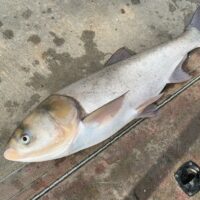
Throughout the year, biologists are involved in several other collaborative research and monitoring projects to slow the spread of invasive carp within the Ohio River basin. If you encounter an invasive carp and are wondering what to do with it, try eating it! Our website includes information on how to clean and prepare silver carp for a tasty meal, as well as descriptions of other DNR projects that address invasive carp.
To learn more please visit DNR: Invasive Carp.
Resources:
Asian carp solutions: Take them to market, Illinois-Indiana Sea Grant
Asian carp, Illinois-Indiana Sea Grant
Asian carp, Purdue College of Agriculture
Invasive Species, Playlist, Purdue Extension – FNR YouTube Channel
What are invasive species and why should I care?, Got Nature? Blog, Purdue Extension – Forestry and Natural Resources
Report Invasive Species, Purdue Invasive Species
Walleye Farmed Fish Fact Sheet, The Education Store, Purdue Extension’s resource center
Pacific White Shrimp Farmed Fact Sheet, The Education Store
Yellow Perch Farmed Fish Fact Sheet, The Education Store
Tilapia Farmed Fish Fact Sheet, The Education Store
Rainbow Trout Farmed Fish Fact Sheet, The Education Store
American Paddlefish, The Education Store
A Guide to Small-Scale Fish Processing Using Local Kitchen Facilities, The Education Store
Eat Midwest Fish, Illinois-Indiana Sea Grant online resource hub
Indiana Department of Natural Resources
Seafood is more than just fish caught in the ocean. It includes a wide variety of product types, forms, flavors, and textures. One of the great things about using seafood is its versatility—it can be served as a main course or be used as an ingredient for appetizers, salads, and soups. Packed with important nutrients the human body needs to maintain good health, it is an excellent source of protein to include on your shopping list. Being informed about both the benefits and potential concerns with different types of seafood can help you decide which products to add to your cart or order at a restaurant.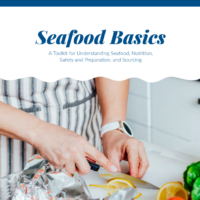
This toolkit, designed specifically for nutrition and wellness professionals and educators, will provide you with information and resources to help you talk to your clients about the complex food category known as seafood. You will learn about the basics of seafood, nutrition benefits of including seafood as part of a healthy eating pattern, concerns about safety, tips for purchasing seafood, and ideas for cooking demonstrations. We’ve included simple and tasty recipes that you can use to introduce your clients to the many flavors of fish and shellfish, links to downloadable and printable handouts, and sample social media posts that you can use to inform and inspire.
This toolkit is geared toward extension staff who teach nutrition and wellness. It includes both printable and digital elements that can be shared with clients based on interest and need.
To receive the free download and recipe visit the Purdue Extension’s resource center: The Education Store – Seafood Basics: A Toolkit for Understanding Seafood, Nutrition, Safety and Preparation, and Sourcing.
Resources:
Purdue Extension – Forestry and Natural Resources– Subscribe to the Youtube channel
Freshwater Prawn Farmed Fish Fact Sheet, The Education Store
Ask An Expert: What is Aquaculture?, Purdue Extension FNR YouTube Channel
Largemouth Bass Market Trends, Purdue Extension – Forestry and Natural Resources (FNR) YouTube Channel
Yellow Perch Farmed Fish Fact Sheet, The Education Store
Tilapia Farmed Fish Fact Sheet, The Education Store
Rainbow Trout Farmed Fish Fact Sheet, The Education Store
American Paddlefish, The Education Store
A Guide to Small-Scale Fish Processing Using Local Kitchen Facilities, The Education Store
Aquaculture Family Coloring Book Development, The Education Store
Channel Catfish, The Education Store
Eat Midwest Fish, Illinois-Indiana Sea Grant online resource hub
Amy Shambach, Aquaculture Marketing Outreach Associate
Purdue Department of Forestry and Natural Resources/Illinois Indiana Sea Grant Program
Hybrid plants and animals can occur in wild environments and are produced by artificially crossing species for the purpose of selective breeding. An example of a popular commercial application is hybrid striped bass, a striped (Morone saxatilis) and white bass (Morone chrysops) cross. Common names include palmetto and sunshine bass. Hybrid striped bass have broken stripes running the length of their bodies, and forked tails. They have two unconnected dorsal fins—one with hard spines. They often are silver above and white below. Coloration depends on environmental factors, like the color of the water. Their flesh has a mild flavor and flakey texture when cooked.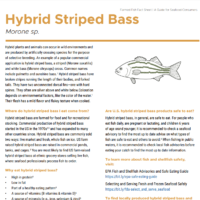
Where do hybrid striped bass I eat come from?
Hybrid striped bass are farmed for food and for recreational stocking. Commercial production of hybrid striped bass started in the US in the 1970s and has expanded to many other countries since. Hybrid striped bass are commonly sold two ways: live market and fresh, whole fish on ice. US farm raised hybrid striped bass are raised in commercial ponds, tanks, and cages. You are most likely to find US farm-raised hybrid striped bass at ethnic grocery stores selling live fish, where seafood professionals process fish to order.
To receive the free download and recipe visit the Purdue Extension’s resource center: The Education Store – Hybrid Striped Bass Farmed Fish Fact Sheet.
Resources:
Freshwater Prawn Farmed Fish Fact Sheet, The Education Store
Ask An Expert: What is Aquaculture?, Purdue Extension FNR YouTube Channel
Walleye Farmed Fish Fact Sheet, The Education Store, Purdue Extension’s resource center
Pacific White Shrimp Farmed Fact Sheet, The Education Store
Yellow Perch Farmed Fish Fact Sheet, The Education Store
Tilapia Farmed Fish Fact Sheet, The Education Store
Rainbow Trout Farmed Fish Fact Sheet, The Education Store
American Paddlefish, The Education Store
A Guide to Small-Scale Fish Processing Using Local Kitchen Facilities, The Education Store
Aquaculture Family Coloring Book Development, The Education Store
Channel Catfish, The Education Store
Eat Midwest Fish, Illinois-Indiana Sea Grant online resource hub
Amy Shambach, Aquaculture Marketing Outreach Associate
Purdue Department of Forestry and Natural Resources/Illinois Indiana Sea Grant Program
Recent Posts
- Discover the Great Lakes, The 2025 Helm Magazine is Available
Posted: November 17, 2025 in Aquaculture/Fish, Aquatic/Aquaculture Resources, Wildlife - Illinois-Indiana Sea Grant Newsletter Shares New Resources
Posted: November 13, 2025 in Aquaculture/Fish, Aquatic/Aquaculture Resources, Wildlife - Publication – Fish Muscle Hydrolysate
Posted: September 15, 2025 in Aquaculture/Fish, Aquatic/Aquaculture Resources - Publication – Direct Marketing Guidebook for Small/Medium-Scale Aquaculture Businesses
Posted: March 7, 2025 in Aquaculture/Fish, Aquatic/Aquaculture Resources, Publication - Conservationists Unite for Snuffbox Mussels – Wild Bulletin
Posted: February 20, 2025 in Aquaculture/Fish, Aquatic/Aquaculture Resources, Wildlife - Publication – Handbook on Processing Fish for Small-Scale Fish Farmers
Posted: October 17, 2024 in Aquaculture/Fish, Aquatic/Aquaculture Resources, How To, Publication, Wildlife - IISG Adds New Water Safety Videos
Posted: May 8, 2024 in Aquaculture/Fish, Aquatic/Aquaculture Resources, Community Development, Great Lakes, Wildlife - Farmers Helping Hellbenders RCPP Program Accepting Applications
Posted: May 1, 2024 in Aquaculture/Fish, Forestry, How To, Wildlife, Woodlands - 2024-25 Fishing Guide now available – Wild Bulletin
Posted: April 4, 2024 in Alert, Aquaculture/Fish, Aquatic/Aquaculture Resources, How To, Ponds, Wildlife - Look Out for Invasive Carp in Your Bait Bucket – Wild Bulletin
Posted: March 31, 2024 in Alert, Aquaculture/Fish, Aquatic/Aquaculture Resources, Invasive Animal Species, Wildlife
Archives
Categories
- Alert
- Aquaculture/Fish
- Aquatic/Aquaculture Resources
- Ask the Expert
- Christmas Trees
- Community Development
- Disease
- Drought
- Forestry
- Forests and Street Trees
- Gardening
- Got Nature for Kids
- Great Lakes
- How To
- Invasive Animal Species
- Invasive Insects
- Invasive Plant Species
- Land Use
- Natural Resource Planning
- Nature of Teaching
- Plants
- Podcasts
- Ponds
- Publication
- Safety
- Spiders
- Timber Marketing
- Uncategorized
- Urban Forestry
- Webinar
- Wildlife
- Wood Products/Manufacturing
- Woodland Management Moment
- Woodlands
